Animal Organisation: Digestion | Biology for Grade 10 PDF Download
Molecules of life
Carbohydrates, proteins, lipids (or fats) are major nutrients that we need in large quantities.
We get these by eating them. They are broken down first and then reassembled into our own carbohydrates, proteins and lipids. This is because:
- most of the molecules in food are too large to pass through the absorbing surface of the gut wall
- the carbohydrates, proteins and lipids are reassembled in the form required, rather than other animal or plant versions
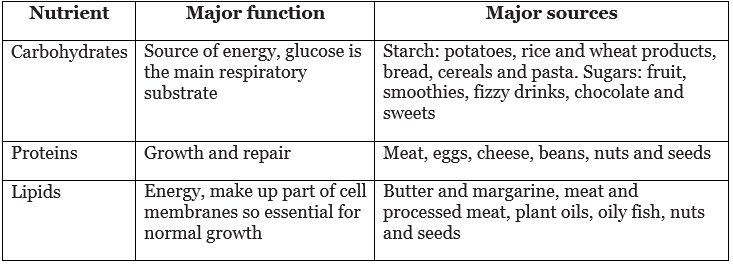
Structures of carbohydrates, proteins and lipids
Carbohydrates
- Carbohydrates in our diet include sugars and starches.
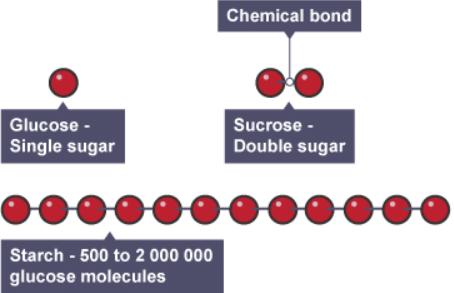
- The glucose molecule is small enough to be absorbed directly through the walls of the digestive system.
- Starch is a polymer of glucose. It must be broken down into glucose molecules – it is too large to pass through the gut.
- Cellulose is also made up of glucose molecules. It makes up plant cell walls. It is therefore a fundamental part of our diet. It cannot be broken down by the digestive system, so is egested from the gut.
- Once absorbed by the body, glucose molecules are transported to cells and:
- used for respiration
- reassembled into the storage form of carbohydrate in animals - glycogen
- In plant metabolism, the glucose produced by photosynthesis is converted into starch for storage, and cellulose, for cell wall synthesis.
- In humans and animals glucose is stored in glycogen. It is not converted into starch.
Proteins
- Proteins are made up of amino acids.
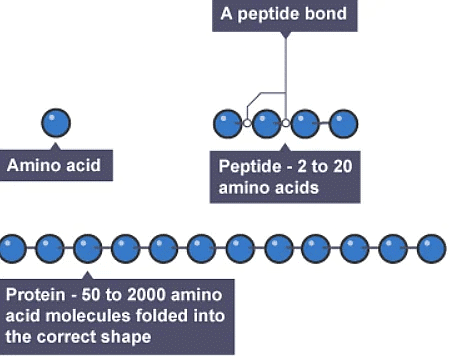
- Proteins are big molecules that are too large to pass through the gut wall. They must first be broken down into amino acids.
- Once inside the body, the amino acids are reassembled into the proteins the individual requires – the process of protein synthesis.
- Excess amino acids are broken down in the liver.
Lipids
- Lipids are esters of fatty acids and glycerol.

In a lipid, there may be 1, 2 or 3 fatty acids combined with glycerol. Fatty acids 1, 2 and 3 may be the same, or different
- Lipid molecules are too large to pass through the gut wall and must be digested first.
- In the body's cells, they are reassembled into the lipids the cell needs, for instance, for the cell membranes.
Required practical activity - food tests
Use qualitative reagents to test for a range of carbohydrates, lipids and proteins
Qualitative tests for foods
- There are several qualitative tests for food chemicals. These can be used to detect the presence of food chemicals, but not how much is present.
Test for sugars
- Benedict's test is used to detect sugars.
Method
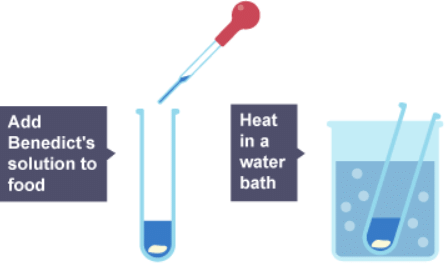
Heat in a water bath
Result

After heating, it may go through stages - green, yellow, orange, red or brown - depending on how much glucose is present
- Sugars classed as reducing sugars will react with Benedict's solution on heating for a few minutes. Glucose is an example of a reducing sugar.
- Reducing sugars give a red-brown precipitate with Benedict's solution. The precipitate takes a while to settle in the tube – you're more likely to see simply a red or brown colour. If there's not much glucose present, the final colour may be green or yellow, or orange if there's a little more.
Hazards
- Wear safety goggles.
- Benedict's solution is an irritant.
- Avoid contact with skin and eyes.
Test for starch
- Add iodine solution to the food being tested.

- Foods containing starch will turn a blue-black colour.
- The iodine test can also be used with a microscope to stain starch grains in plant cells.
Hazards
- Wear safety goggles.
- Iodine solution is an irritant.
- Avoid contact with skin and eyes.
Test for proteins
- The biuret test is used to detect proteins.
- Biuret reagent is sometimes available as a single solution.
Method
- Add 1 cm3 of biuret solution A to the food solution.
- Mix the liquids.
- Add 1 cm3 of biuret solution B and shake.
Results
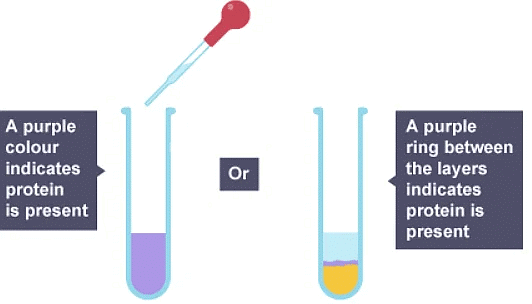
Hazards
- Wear safety goggles.
- Biuret solution A is corrosive.
- Biuret solution B is an irritant.
- Avoid contact with skin and eyes.
Test for fats
- The Sudan III test
- The Sudan III test is one test used to test for lipids.
Method
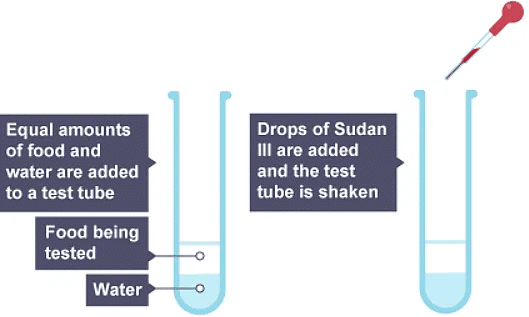
Results
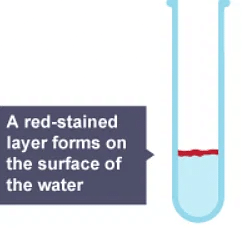
Hazards
- Wear safety goggles.
- Sudan III solution is flammable as it is dissolved in alcohol.
- Avoid contact with skin and eyes.
The emulsion test
- The emulsion test is an alternative test for lipids.
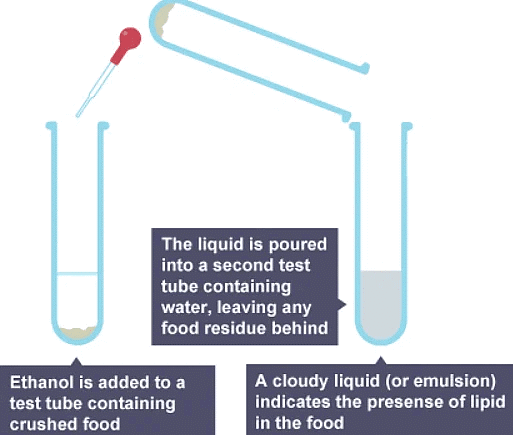
Hazards
- Wear safety goggles.
- Ethanol is flammable.
- Avoid contact with skin and eyes.
The human digestive system
The human digestive system has two functions:
- breaks down complex food substances
- provides the very large surface area for maximum absorption of food
The structure of the digestive system
- Regions of the digestive system are adapted to the digestion and absorption of food:
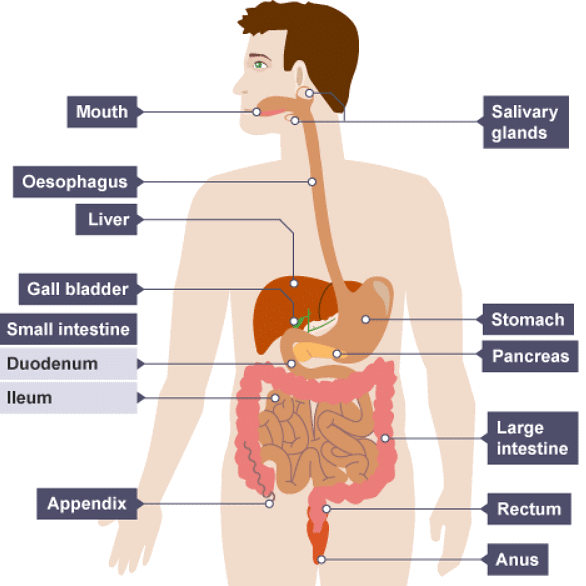
Digestion
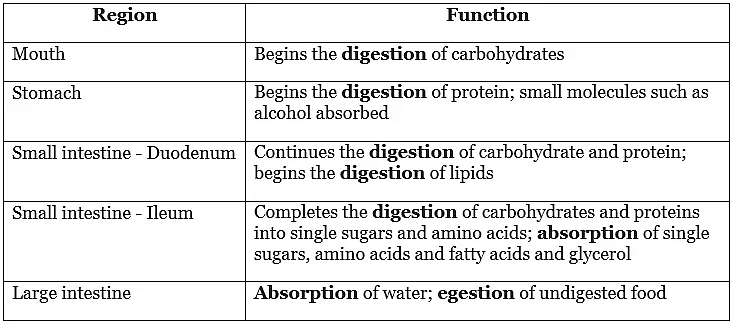
- Digestive enzymes are used to break down food in the gut into small, soluble molecules that can be absorbed through the gut wall.
Absorption
- The surface of the small intestine wall is folded, and has projections called villi.
Villi is the plural of villus.
- The epithelial cells that cover each villus themselves have projections called microvilli.
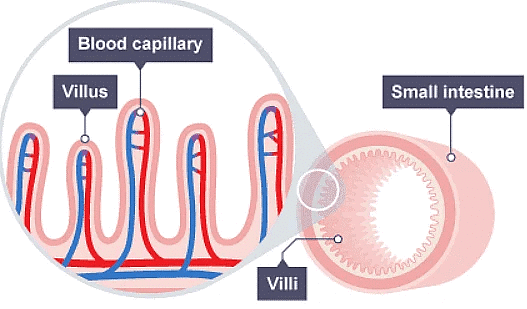
- A close up of the villi in the small intestine
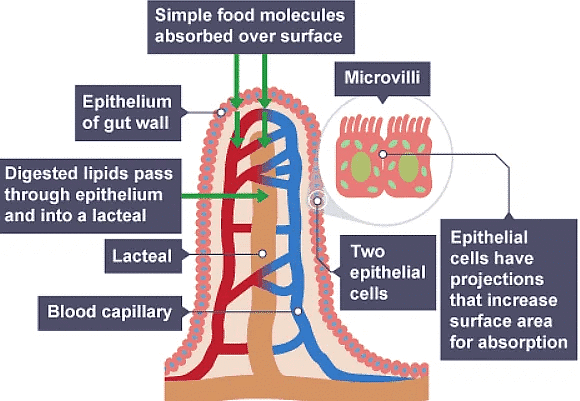
Cross-section of a villus
- These all increase the surface area over which digested food – now simple molecules – is absorbed.
- Most of the digested food passes through the epithelial cells of the gut wall and is carried by blood to the liver. Digested lipids pass through the gut wall and enter the lacteals.
Enzymes
- Most of the food we eat is complex carbohydrates, proteins and lipids. These must be broken down to be absorbed into the body.
- The chemical reactions required to break them down would be too slow without enzymes.
- Enzymes are biological catalysts– they speed up chemical reactions.
- Enzymes are required for most of the chemical reactions that occur in organisms. These reactions occur in the breakdown of chemical molecules, which we see in the digestive system.
- Enzymes are also involved in the building up of chemical molecules elsewhere in the body.
- Enzymes are proteins that have a complex 3D shape. Each enzyme has a region called an active site.
- The substrate – the molecule or molecules taking part in the chemical reaction – fits into the active site. Once bound to the active site, the chemical reaction takes place.
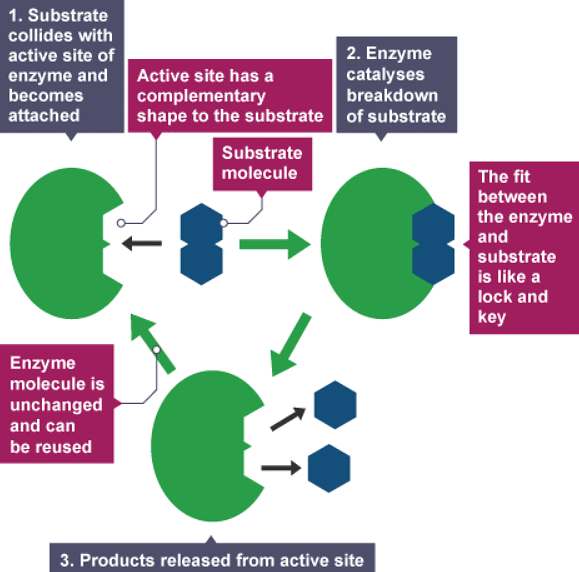
- In an organism, the active site of each enzyme is a different shape. It is a perfect match to the shape of the substrate molecule, or molecules. This is essential to the enzyme being able to work. One enzyme is therefore specific to one substrate's chemical reaction, or type of chemical reaction.
- This theory for the way in which enzymes work is called the lock and key theory.
Factors affecting enzyme action
- Physical factors affect enzyme activity.
Temperature
- At low temperatures, the number of successful collisions between the enzyme and substrate is reduced because their molecular movement decreases. The reaction is slow.
- The human body is maintained at 37°C as this is the temperature at which the enzymes in our body work best. This is not true of the enzymes in all organisms.
- Higher temperatures disrupt the shape of the active site, which will reduce its activity, or prevent it from working. The enzyme will have been denatured.
- Enzymes therefore work best at a particular temperature.
Enzyme action
- Proteins are chains of amino acids joined end to end. This chain is not straight – it twists and folds as different amino acids in the chain are attracted to, or repel each other.
- Each enzyme is made from proteins made of these twisting and folding amino acids, and therefore the enzyme has a unique shape. This structure is held together by weak forces between the amino acid molecules in the chain.
- High temperatures will break these forces. The enzyme, including its active site, will change shape and the substrate will no longer fit. The rate of reaction will be affected, or the reaction will stop.

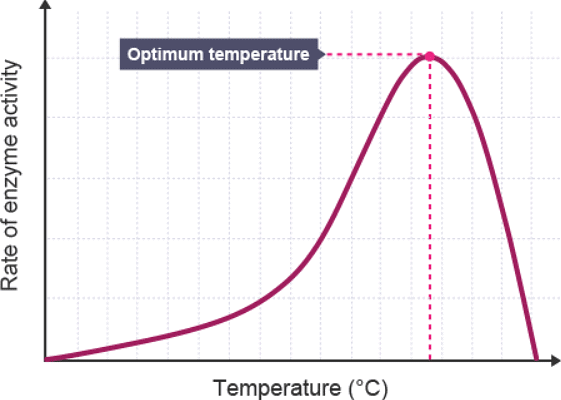
A graph showing the effect of temperature on enzyme activity
The effect of pH
- Enzymes are also sensitive to pH. Changing the pH of its surroundings will also change the shape of the active site of an enzyme.
- Many amino acids in an enzyme molecule carry a charge. Within the enzyme molecule, positively and negatively charged amino acids will attract. This contributes to the folding of the enzyme molecule, its shape, and the shape of the active site.
- Changing the pH will affect the charges on the amino acid molecules. Amino acids that attracted each other may no longer. Again, the shape of the enzyme, along with its active site, will change.
- Extremes of pH also denature enzymes. The changes are usually permanent.
- Enzymes work inside and outside cells, for instance in the digestive system where cell pH is kept at 7.0 to 7.4. Cellular enzymes will work best within this pH range. Different parts of the digestive system produce different enzymes. These have different optimum pHs. The optimum pH in the stomach is produced by the secretion of hydrochloric acid.
- The optimum pH in the duodenum is produced by the secretion of sodium hydrogencarbonate.
- The following table gives examples of how some of the enzymes in the digestive system have different optimum pHs:
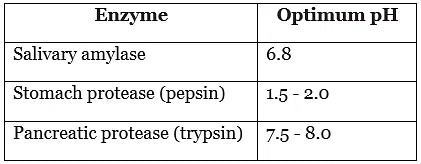
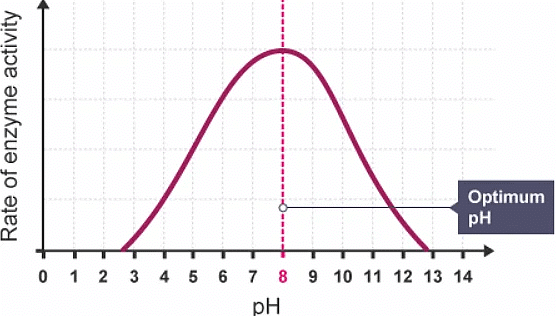
A graph showing the effect of pH on enzyme activity
Example: Suggest an enzyme that would produce a trend as shown in the graph above.
Pancreatic protease (trypsin).
Digestive enzymes
- The groups of enzymes involved in the breakdown of food are:
- Carbohydrases break down carbohydrates:

- Starch is a type of carbohydrate. The carbohydrase that breaks down starch is amylase:

- Proteases break down proteins:

- Lipases break down lipids:

Carbohydrases
- Carbohydrases break down carbohydrates in several regions of the digestive system.
- Most of the carbohydrate we eat is starch, so this will be the main substrate in the early part of digestion for enzyme action.
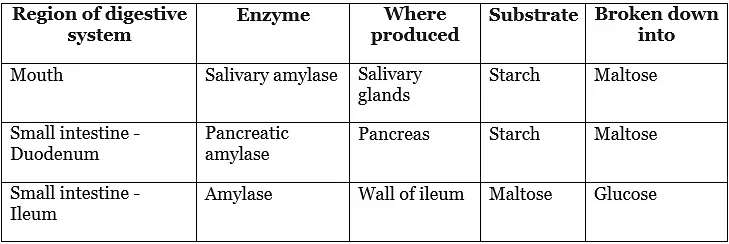
Proteases
- Proteases break down proteins in several regions of the digestive system.
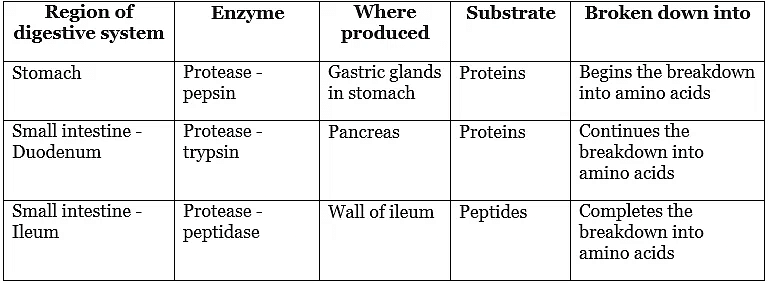
Lipases
- Lipases break down lipids in one region of the digestive system.

 |
Download the notes
Animal Organisation: Digestion
|
Download as PDF |
Required practical activity
Investigate the effect of pH on the rate of reaction of amylase enzyme
Aim
- To determine the rate of the amylase activity at different pHs.
Method
- You will investigate the breakdown of starch by amylase at different pHs.
- The different pHs under investigation will be produced using buffer solutions. Buffer solutions produce a particular pH, and will maintain it if other substances are added.
- The amylase will break down the starch.
- A series of test tubes containing a mixture of starch and amylase is set up at different pHs.
- A sample is removed from the test tubes every 10 seconds to test for the presence of starch. Iodine solution will turn a blue/black colour when starch is present, so when all the starch is broken down, a blue-black colour is no longer produced. The iodine solution will remain orange-brown.
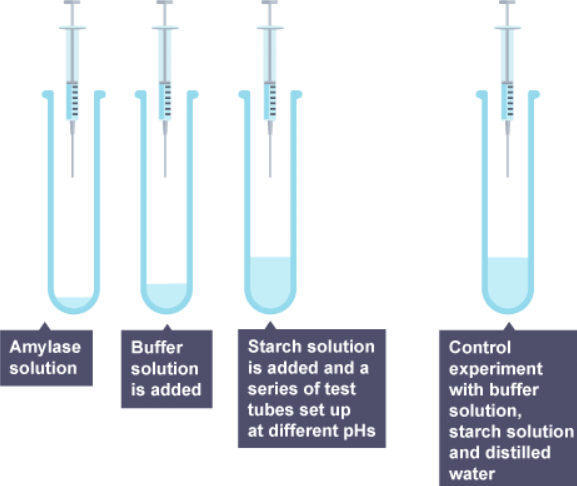
- A control experiment must be set up – without the amylase – to make sure that the starch would not break down anyway. The result of the control experiment must be negative – the colour must remain blue-black – for results with the enzyme to be valid.
- When the starch solution is added:
- start timing immediately
- remove a sample immediately, and test it with iodine solution
- sample the starch-amylase mixture continuously, for example every 10 seconds
This is how you might set up the experiment:
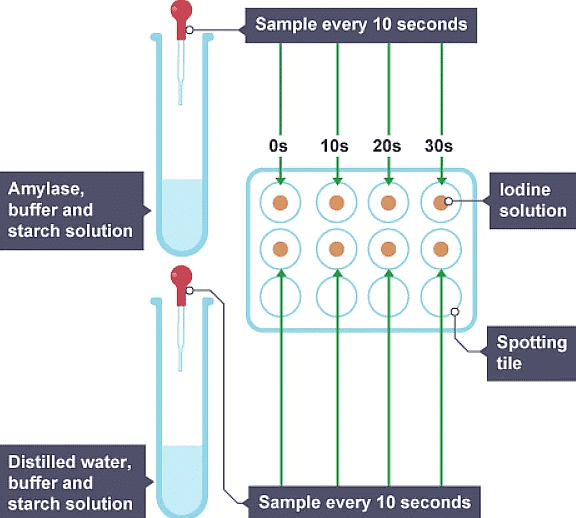
- For each pH investigated, record the time taken for the disappearance of starch, ie when the iodine solution in the spotting tile remains orange-brown.
Hazards
- Wear safety goggles.
- Amylase solution may cause allergic reactions.
- Iodine solution is irritant. Avoid contact with skin and eyes.
Example results
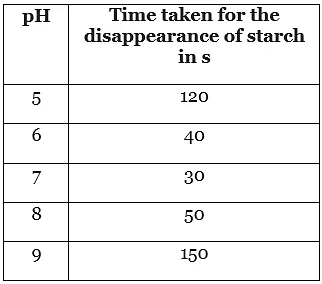
- The time taken for the disappearance of starch is not the rate of reaction.
- It will give us an indication of the rate, but is the inverse of the rate – the shorter the time taken, the greater the rate of the reaction.
- We can calculate the rate of the reaction by calculating 1/t, obtaining a measure of the rate of reaction by dividing one by the time taken for the reaction to occur.
So, from the results:
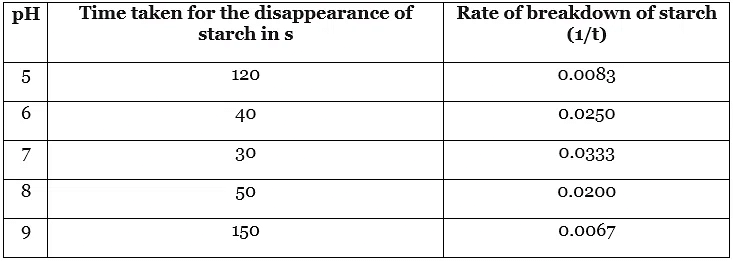
- Plot a graph of rate of reaction against pH.
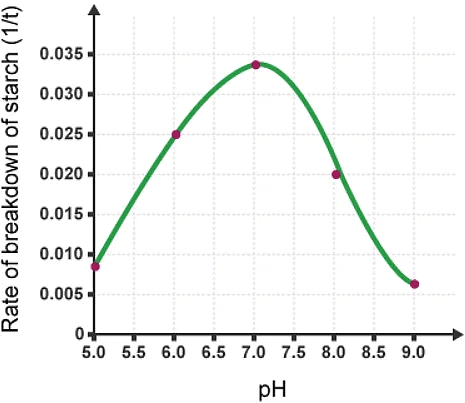
- A similar experiment can be carried out to investigate the effect of temperature on amylase activity.
- Set up a series of test tubes in the same way and maintain these at different temperatures using a water bath – either electrical or a heated beaker of water.
- Depending on the chemical reaction under investigation, you might monitor the reaction in a different way. If investigating the effect of temperature on the breakdown of lipid by lipase, for instance, you could monitor pH change – lipids are broken down into fatty acids and glycerol. As the reaction proceeded, the release of fatty acids would mean that the pH would decrease.
The liver and digestion
- The liver does not secrete any enzymes, but it plays an important role in digestion, and then processing food molecules that have been absorbed.
- The liver produces bile.
Bile:
- Emulsifieslipids, breaking them up physically into tiny droplets. Tiny droplets have a much larger surface area, over which lipases can work, than larger pieces, or drops of lipid.

- Contains sodium hydrogencarbonate, which is an alkali. It neutralises stomach acid and produces the optimum pH for pancreatic enzymes.
- Is produced in the liver, but stored and concentrated in the gall bladder.
|
110 videos|93 docs|9 tests
|





















